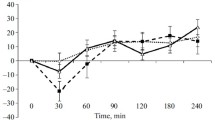Abstract
A rat warm-water tail-withdrawal procedure was used to examine the effects of chronic administration of the competitive NMDA receptor antagonist LY235959 in morphine tolerant rats. Morphine dose-dependently increased tail-withdrawal latencies from 55°C water. When morphine (10 mg/kg) was administered twice-daily for 7 days, the morphine dose-effect curves shifted 0.3–0.5 log unit to the right. When morphine was administered for an additional 7 days, the morphine dose-effect curve shifted 0.4 log unit further to the right. Co-administration of LY235959 (1, 3, 10 mg/kg) along with morphine prevented the development of tolerance observed during the second week of chronic morphine administration. Although the highest dose of LY235959 (10 mg/kg) partially reversed tolerance in five of seven rats, tolerance was not reversed by lower doses of LY235959. These data suggest that NMDA receptor antagonists may effectively prevent the progressive development of morphine tolerance at doses that are not sufficient to reverse pre-established morphine tolerance.
Similar content being viewed by others
Author information
Authors and Affiliations
Additional information
Received: 10 June 1998/Final version: 19 August 1998
Rights and permissions
About this article
Cite this article
Allen, R., Dykstra, L. The competitive NMDA receptor antagonist LY235959 modulates the progression of morphine tolerance in rats. Psychopharmacology 142, 209–214 (1999). https://doi.org/10.1007/s002130050881
Issue Date:
DOI: https://doi.org/10.1007/s002130050881




